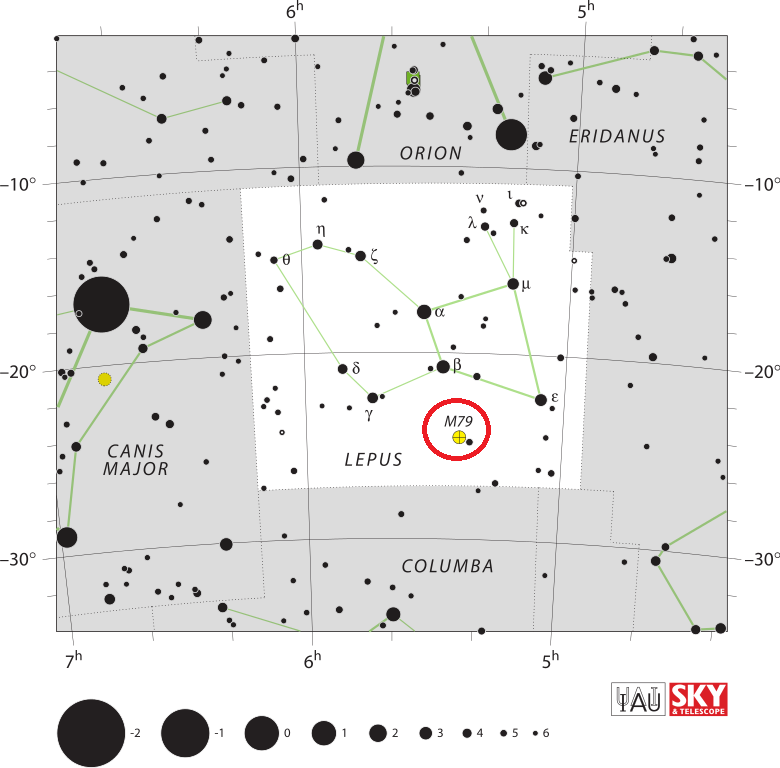Messier 79 (M79) is a globular cluster located in the northern constellation Lepus, the Hare. The cluster lies at a distance of 41,000 light years from Earth and has an apparent magnitude of 8.56. It has the designation NGC 1904 in the New General Catalogue.
Messier 79 occupies an area of 8.7 arc minutes of apparent sky, which corresponds to a spatial extension of about 104 light years. In small binoculars, it appears as a fuzzy star, while small telescopes reveal a comet-like patch of light with a bright core. 10-inch orn larger telescopes are required to resolve the cluster’s outer regions.
The cluster is relatively easy to find because it lies just south of the prominent hourglass shape of Orion and west of Canis Major. M79 is located 20 degrees to the southwest of Sirius, the brightest star in the sky.
An imaginary line drawn from Betelgeuse to Saiph, the bright stars marking Orion‘s left shoulder and left foot, leads to the two brightest stars in Lepus, named Arneb (Alpha Leporis, mag. +2.58) and Nihal (Beta Leporis, mag. +2.81). A line from Arneb to Nihal extended for about 1.5 times the distance between the two stars leads to the fifth magnitude star HR 1771 (HD 35162, HIP 25045), which has a 7th magnitude companion. HR 1771 is located only 0.5 degrees southwest of M79 and appears in the same binocular field of view. The best time of year to observe the cluster is during the winter.
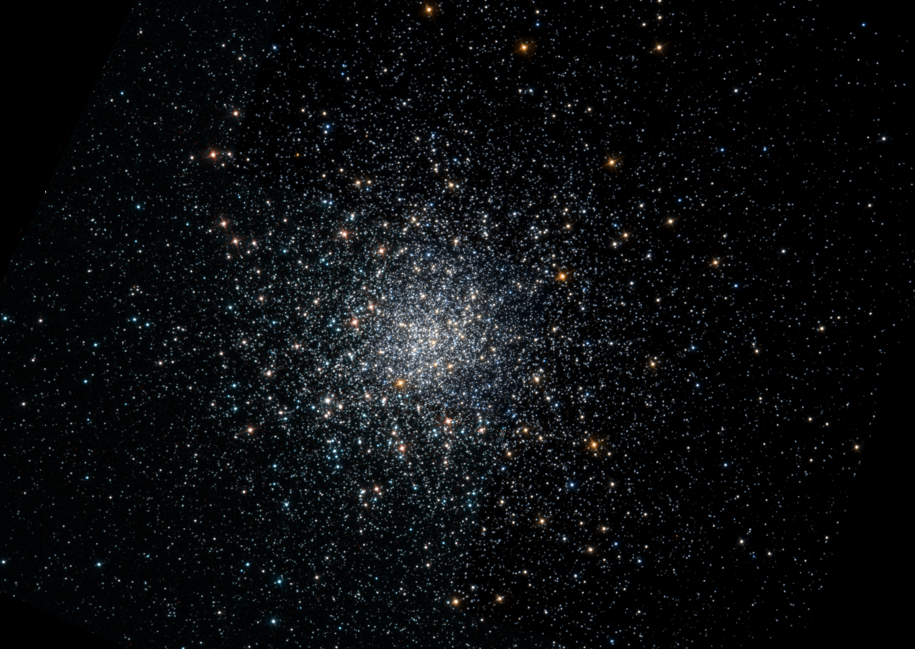
Messier 79 lies in an unusual location, about 60,000 light years from the Milky Way galactic centre, in the hemisphere opposite the galactic centre. The cluster is suspected to have immigrated from the neighbouring Canis Major Dwarf Galaxy, which is currently experiencing a close encounter with the Milky Way. There are three other globular clusters that are believed to share a similar origin: NGC 1851, NGC 2298 and NGC 2808. The Milky Way is currently in the process of absorbing the Canis Major Dwarf and it is pulling a vast tidal tail of material from the smaller galaxy, including its globular clusters.
The only other extragalactic globular listed in the Messier catalogue, Messier 54, is believed to belong to the Sagittarius Dwarf Elliptical Galaxy, a satellite galaxy of the Milky Way.
Messier 79 contains about 150,000 stars. Most of them are red giants and there are also many blue stragglers, old stars that appear younger and bluer than their neighbours as a result of interactions and collisions with other stars in the densely populated core of M79. The estimated age of M79 is 11.7 billion years. The cluster is receding from us at about 200 km/s.
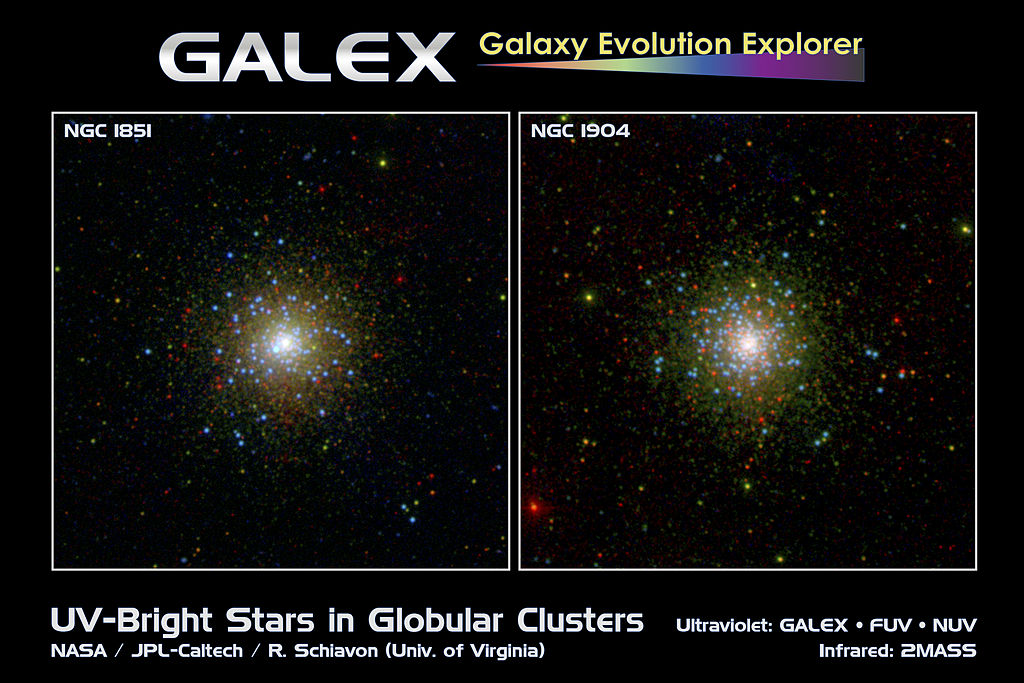
The blue dots represent a class of stars called Hot Horizontal Branch Stars. In death, these stars shed about 85 percent of their atmosphere and leave behind only a very hot and extremely ultraviolet-bright core. As a contrast, both clusters’ populations of “very cold” stars are shown as red points.
NGC 1904 is located approximately 50,000 light years away in the constellation Lepus, and NGC 1851 lives 40,000 light years away in the southern constellation Columba.
These images combine far-ultraviolet (blue) and near-ultraviolet (green) information from NASA’s Galaxy Evolution Explorer (GALEX) with infrared J-band (red) data from the Two Micron All Sky Survey (2MASS). Image: NASA/JPL-Caltech/University of Virginia/R. Schiavon (Univ. of Virginia)
There are 12 to 13 known variable stars in M79, including 10 RR Lyrae type variables, a semiregular variable and a long period variable.
The cluster has the density classification V, which means that its core is quite dense. M79 may have undergone a core collapse like a number of other globulars, including Messier 15, Messier 30, Messier 70 and possibly Messier 62.
Messier 79 was discovered by the French astronomer Pierre Méchain on October 26, 1780. Méchain reported his discovery to his friend Charles Messier, who determined the position of the object and added it to his catalogue on December 17, 1780 with the following note:
Nebula without star, situated below Lepus, & on the same parallel as a star of sixth magnitude: seen by M. Méchain on October 26, 1780. M. Messier looked for it on the following December 17: this nebula is beautiful; the center brilliant, the nebulosity a little diffuse; its position was determined from the star Epsilon Leporis, of fourth magnitude.
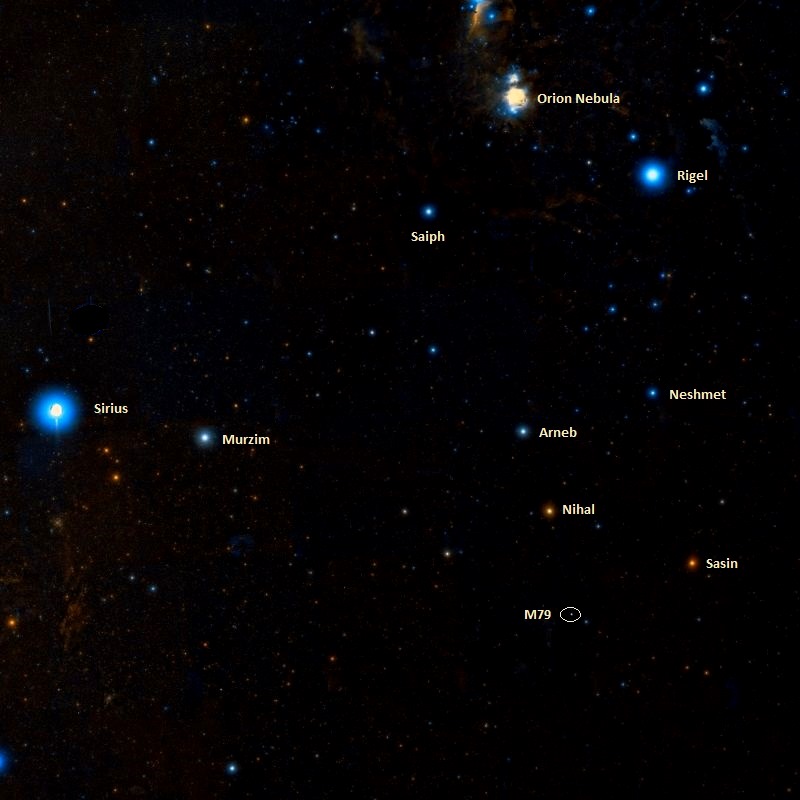
William Herschel was the first to resolve the cluster into stars around 1784 with his 20-foot telescope. He described M79 as a “beautiful cluster of stars, nearly 3 minutes in diameter.” He offered a more detailed description after observing the cluster on January 13, 1806 in his large 10-foot telescope:
The 79th of the Connoiss. [Messier 79] is a cluster of stars of a globular construction, and certainly extremely rich. Towards the centre the stars are extremely compressed, and even a good way from it. With 171 the diameter is a little less than 1/3 of the field, and with 220 a little more; the field of one being 9’0″, and of the other 8’0″, a mean of both gives the diameter of the cluster 2’50”, but I suppose that the lowness of the situation prevents my seeing the tiny scattered stars, so that this cluster is probably larger than it appears.
John Herschel added M79 to the General Catalogue as GC 1112, describing it as a “globular cluster; pretty large; extremely rich; extremely compressed; well resolved.”
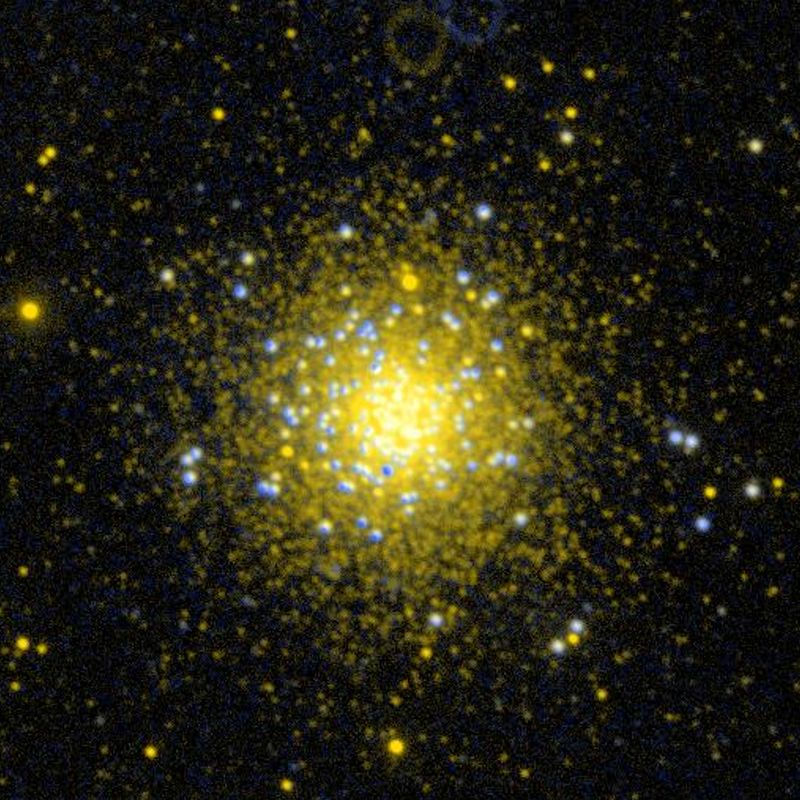
Admiral William Henry Smyth observed the cluster in December 1835 anf offered the following note:
A bright stellar nebula, of a milky white tinge, under the Hare‘s feet, the following edge of whose disc just precedes a line formed by two stars lying across the vertical, and it is followed nearly on the parallel by a 9th-magnitude star. It is a fine object, blazing towards the centre, and was discovered by Méchain in 1780. It was resolved by WH into a mottled nebulosity, in 1783, with the 7-foot telescope; but on applying the twenty-foot in the following year, he fairly made it a “beautiful cluster of stars nearly 3 minutes [of arc] in diameter, of a globular construction, and certainly extremely rich.” The mean apparent place is obtained by differentiating from Xi Leporis, which is a fine white star, with a red companion of the 7th magnitude in the np [north preceding, NW] quadrant. An imaginary line run from Betelgeuze before Alpha Leporis and over Beta, will hit this object about 4deg south-west of the latter.
FACTS
| Object: Cluster |
| Type: Globular |
| Class: V |
| Designations: Messier 79, M79, NGC 1904, GCl 10, C 0522-245, CD-24 3058, HD 35512, GCRV 3251, 1E 0522.1-2433, MWSC 0528, CPD-24 931 |
| Features: Extragalactic cluster |
| Constellation: Lepus |
| Right ascension: 05h 24m 10.59s |
| Declination: -24°31’27.3” |
| Distance: 41,000 light years (13,000 parsecs) |
| Age: 11.7 billion years |
| Number of stars: 150,000 |
| Apparent magnitude: +8.56 |
| Apparent dimensions: 8′.7 |
| Radius: 52 light years |
LOCATION
